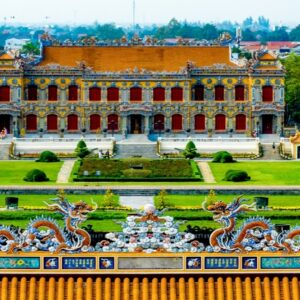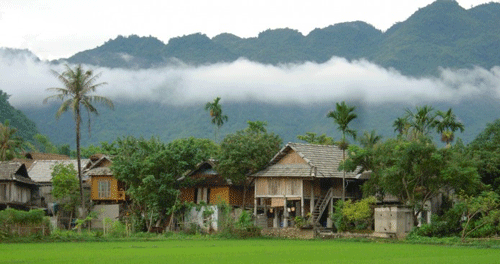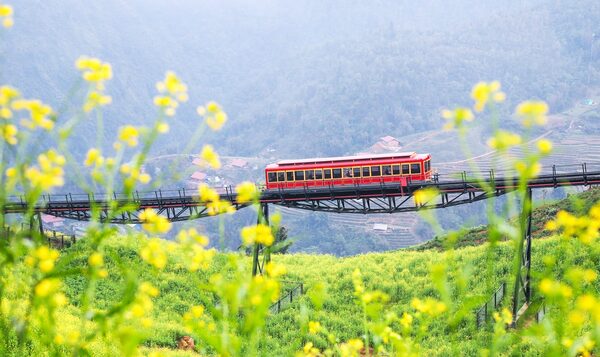Ranked among the must-visit sites in Hue, alongside the Imperial City, Perfume River, and Truc Lam Bach Ma Monastery, Kien Trung Palace captivates travelers with its unique beauty.
Despite its complete destruction in 1946, this palace has been restored and rebuilt. At the beginning of 2024, Kien Trung Palace in Hue officially reopened its doors with a renewed appearance, offering visitors an immersive experience in Vietnam’s history.
Overview of Kien Trung Palace in Hue, Vietnam
Kien Trung Palace is one of the most significant symbols of the Nguyen dynasty, still present within the Imperial Citadel area of Hue, Vietnam. Begun in 1921, this place was used as a workplace by the last two kings of the Nguyen dynasty.
Although it was almost entirely destroyed in 1946, through the restoration efforts of heritage preservation organizations, Kien Trung Palace has been fully restored, blending antique beauty with the modern 20th-century architecture of Hue, Vietnam, making it a favored destination for many international tourists on their Vietnam tours.
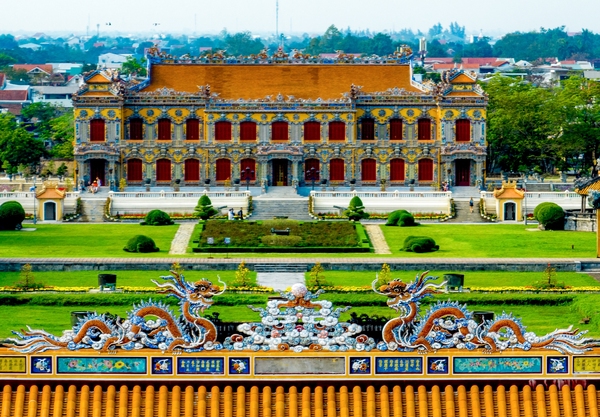
Splendid Beauty of Kien Trung Palace seen from above (Photo: VGP/Le Hoang)
- Address: 32 Dang Thai Than Street, Phu Hau Ward, Hue City, Vietnam.
- Opening Hours: 7:30 AM – 5:30 PM on weekdays
- Ticket Price:
| Adult | Child (<1.3 meters) |
| 200.000 VND/person (8.10 USD) | 40.000 VND/person (1.62 USD) |
History of Kien Trung palace
In 1827, King Minh Mang initiated the construction of the Minh Vien Pavilion, a towering edifice with three stories reaching about 10.8 meters in height. Regrettably, Emperor Tu Duc oversaw the demolition of this structure later on.
In 1913, King Duy Tan took steps to establish a new pavilion, known as Du Cuu.
Between 1921 and 1923, King Khai Dinh embarked on an ambitious project to expand this area, transforming it into a palace dubbed Kien Trung Palace, where he resided amidst the imperial surroundings.
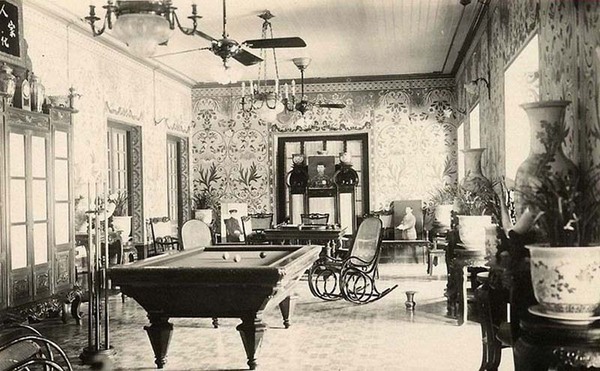
Under the rule of King Bao Dai, Kien Trung Palace underwent modernization with amenities imported from the West.
Under the rule of King Bao Dai, Kien Trung Palace underwent modernization with amenities imported from the West.
In December 1946, the Vietminh army executed a decentralization strategy, resulting in the complete destruction of Kien Trung Palace. The flames of war engulfed the Imperial Citadel of Hue in 1947, reducing the palace to mere foundations and fences.
Following these tumultuous events, on February 16, 2019, the People’s Committee of Thua Thien Hue Province, in partnership with the Old Town Heritage Conservation Center of Hue, commenced the restoration of this historic palace, aiming to promote tourism and preserve cultural heritage.
In 2024, after extensive restoration efforts, the Kien Trung Palace in Hue, Vietnam, proudly reopened its doors to visitors, symbolizing a resurgence of its rich historical legacy.
How to Get to This Palace?
The Kien Trung Palace is situated near the center of Hue city, approximately 2.7 kilometers away, and takes less than 10 minutes by car. You can access it through various means such as taxi, bus, or scooter, depending on your preferences.
If you’re looking for directions, simply head towards Phu Xuan Bridge, then turn left onto Le Duan Street, take a right onto Cua Ngan, and continue onto 23 Thang 8 Street and Doan Thi Diem. Once you’ve crossed this street, you’ll see Cua Quang Duc Street, and following it will lead you to Dai Noi, where the Kien Trung Palace is located.
Architecture of Kien Trung Palace
The architecture of Kien Trung Palace is characterized by its unique blend of Italian Renaissance, French, and traditional Vietnamese architectural styles.
In front of the palace, there is a garden. The main gate is adorned with sculptures, including porcelain dragons and unicorns, which reflect the influence of French architecture.
Dragon motifs featuring five claws, representing the power of the Nguyen dynasty, decorate the palace’s outer walls. The striking red doors are adorned with vibrant trees and flowers.
Visitors are welcomed into the palace by three staircases intricately decorated with dragon imagery. The main level features a total of 13 louvered doors, with 5 positioned centrally and 3 on each side. The elaborate dragon and floral designs on the palace’s main gate are both beautiful and refined.
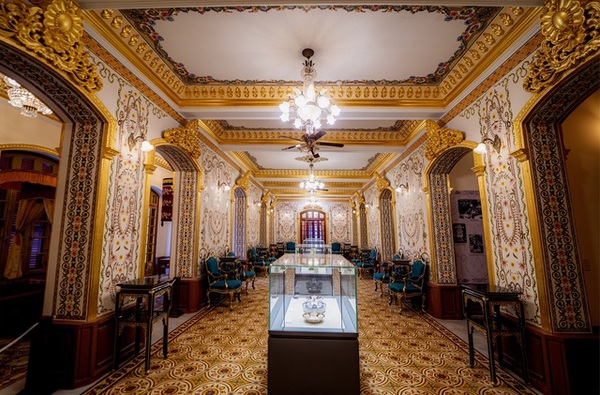
Interior furnishings of Kien Trung Palace (photo: VGP/Le Hoang)
Inside Kien Trung Palace, there lies a truly sumptuous and awe-inspiring setting, reflecting the grandeur of the Nguyen dynasty. The furnishings are elegantly displayed, intertwined with the palace’s history, allowing visitors to grasp and relive the historical events of the Nguyen dynasty in the 1980s and 1990s.
The upper level of the palace features a mezzanine, designed in a style akin to the main level, with a tiled roof adorned in traditional Vietnamese fashion.
Best time to visit the Palace
You can visit Kien Trung Palace in Hue, Vietnam, at any time of the year as it remains open year-round to welcome tourists.
However, for an optimal experience, consider visiting the palace during the best season in Hue, Vietnam, which spans from November to April of the following year, particularly between March and April.
During this period, the weather in Hue, central Vietnam, is typically cool, sunny, with minimal rainfall, and the air is refreshing, making it highly conducive for leisure, sightseeing, and exploration activities.
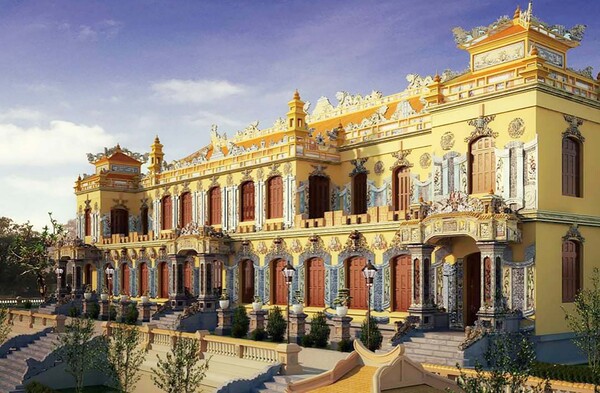
Should visit Kien Trung Palace between March and April
Travel tips for Kien Trung Palace
To make the most of your visit, here are some important tips:
- Kien Trung Palace in Hue, Vietnam, is located within the imperial citadel of Hue and is quite extensive, comprising numerous different mausoleums. Visitors are advised to carry a map to avoid getting lost; you can obtain one at the entrance of the site.
- It is recommended for visitors to wear appropriate and respectful clothing when entering the monuments. You can rent traditional Vietnamese costumes or ao dai to take photos and keep beautiful memories.
- It is important to respect the rules of the monuments, not to photograph the interior of the buildings or touch the displayed objects, and to ensure the cleanliness and overall aesthetics of the site.
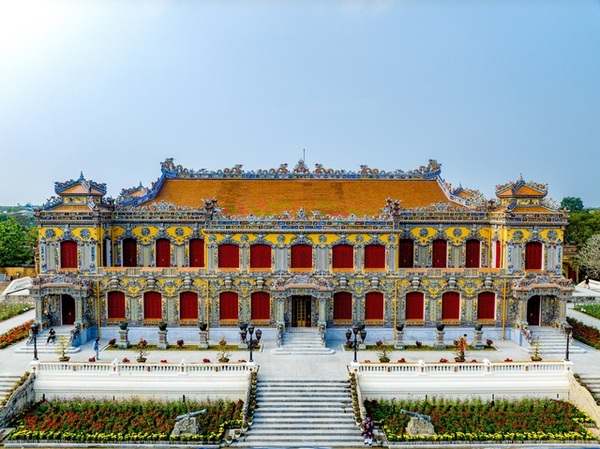
Unique architecture of the Nguyen dynasty palace, featuring a blend of French, Italian, and traditional Vietnamese architectural styles (Photo: VGP/Le Hoang)
Travel to Vietnam, Kien Trung Palace holds extreme significance in terms of history, culture, and art, symbolizing the ancient imperial citadel of Hue, once the capital of the Nguyen dynasty.
It is a major tourist site in Hue, allowing visitors to explore Vietnam’s glorious history and the last dynasty of the Nguyen lords. Kien Trung Palace is also a place that carefully preserves heritage from glorious moments to vicissitudes through the centuries, notably within the imperial citadel.
Read more: 5 Must-try Foods When You Visit Hue

